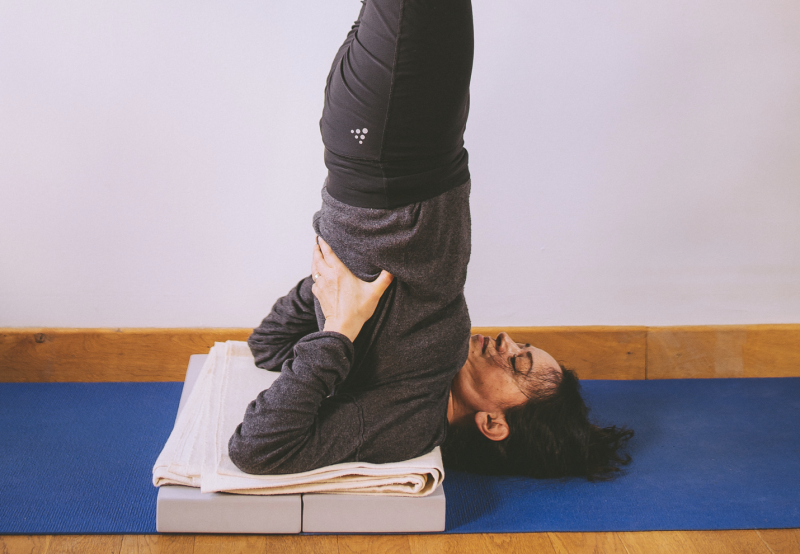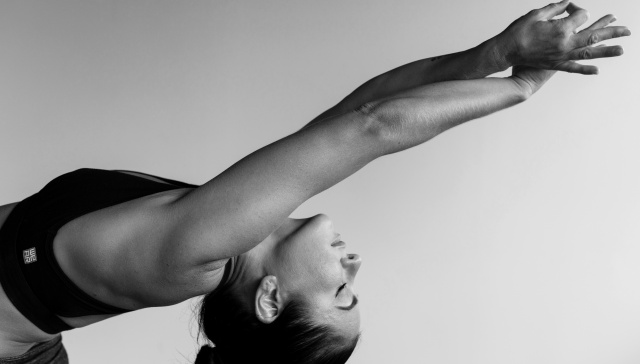Shoulder Stand
Salamba Sarvangasana

The Salamba Sarvangasana yoga pose, also known as the shoulder stand, is a challenging pose physically, but also mentally like most inversions. We don't often go upside down, and it does affect our perception and our balance.
Reversing gravity also seems to help organs, lymph and blood detoxify. Shoulder stand usually happens quite late in the practice, just before Savasana, and sometimes just after the headstand (Sirsasana).
In this blog post, we will explain how to practice the shoulder stand safely and effectively.
What does Salamba Sarvangasana mean?
In Sanskrit, Salamba means " supported" and Sarvangasana is derived from two Sanskrit words, sarva meaning "all" and anga meaning "limb." When combined, these words mean "all limbs," which refers to the many ways in which this pose can improve your health.
Benefits of Sarvangasana
Sarvangasana is actually one of the most beneficial poses you can do. It offers a wide range of benefits, both physical and mental, which is why it’s often called the “Queen of Asanas.” Let’s take a closer look at some of the benefits offered by this powerful pose.
1. Physical benefits:
- Increased blood circulation throughout the body
- improved thyroid function
- improved digestion
- relief from neck pain
- improved immunity
2. Mental benefits:
- calms the mind and reduces stress and anxiety
- helps with insomnia or difficulty sleeping
- increases focus and concentration
How to perform the shoulder stand
The shoulder stand is a challenging yoga pose that requires supervision if you've never done it.
It is one of the first inversion poses that you'll learn as a beginner, but you have to be careful not to get injured while practising it:
- Never turn your head when you're in the pose
- Always have a support under your shoulders (specially if you attend an Iyengar class)
- Do not stay in the pose too long when you start, build resistance gradually
Here is a step-by-step guide on how to perform the shoulder stand, and how to come down from the pose.
Instructions:
1. Begin by lying on your back on the support. Make sure your is head off the support, and shoulders well on the support. Legs bent and feet flat on the ground. Place your hands on the floor beside you, palms down (you can also hold the sides of your mat)
2. Press your hands and rock back, having your knees above your head. Make sure both shoulders stay aligned and on the support. You're trying to be on top of your shoulders.
3. Place your hands on your back, lifting your rib cage between your thumb and your index
4. Stretch your spine and your legs, feet in a ballerina position, making space in between the rib cage and the hips, pressing your elbows in the support, trying to reach the ceiling. You can hold this pose for a few minutes.
5. To go down from the pose, you usually change into Halasana ( plough pose), and from Halasana you would rock back softly on your back, feet flat on the floor,
6. Push back towards your head to slide off your support and cross your legs both ways on your support, before turning to your right to stand up.
Sarvangasana variations
One variation to Salamba Sarvangasana is Eka Pada Sarvangasana, or one-legged shoulder stand. To perform Eka Pada Sarvangasana, start in Sarvangasana with your feet together. Keep your left leg up into the air and extend the right leg towards your head, making sure to keep the hips aligned. If you're flexible, you can try and reach the floor, but if you are stiff, you'll probably stay around 90°. This variation should help you get more height! Repeat with the 2nd leg.
Another variation is Baddha Konasana Sarvangasana, or even Padmasana Sarvangasana or lotus shoulder stand. This pose is a great way to stretch the hips and improve flexibility in the hamstrings and groin muscles, and it makes the pose a bit lighter for a moment.
To perform Baddha Konasana Sarvangasana, start in Sarvangasana, and lower your feet joining your heels and toes together until the palm of the feet presses against each other. you can hold the pose for a few minutes then either open the legs wide and back in Sarvangasana, or just legs straight up in Sarvangasana.
Required props for Sarvangasana
As the word "Salamba" suggests ("supported"), Salamba Sarvangasana is best practised on a support.
You can use folded blankets or blocks. In an Iyengar class, you would use 4 blocks or 4 blankets.
If you're attending an Iyengar livestream class, make sure you plan your props ahead of time. You can use what you have at home if required: books (for blocks), tins (for bricks), beach towels (for blankets), and dressing gown belts (straps).
You can also use a chair for a Chair Shoulder Stand, which is a very comfortable way to practice: your pelvis is supported by the chair, and your shoulder are on the bolster on the floor. Legs can extend on the back of the chair or up in vipareeta karani.
Most popular yoga poses in the UK
Shoulder stand is a popular pose in the UK with 880 searches per month on Google. But Downward Dog Is the top searched yoga pose with 8100 searches a month, followed by Handstand (3,600), headstand (1,600), and warrior pose (1000 searches a month). Trikonasana comes after Shoulder stand with 590 searches a month.
 Live Yoga Teachers
Live Yoga Teachers
